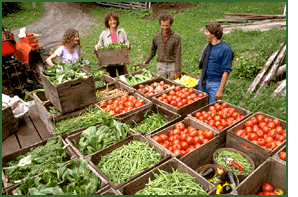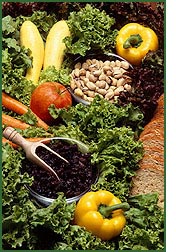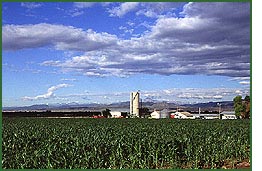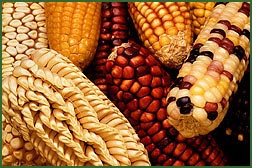From the Roots Up
By Murray MacAdam
 |
Small, independent farmers are an endangered species. So some consumers are putting their money where their mouths are, by sharing the bounty - and the risk. |
It was a heart-warming sight, even for a hot summer's day. Moved by the plight of drought-stricken western farmers forced to sell cattle because they couldn't afford to feed them, farmers in eastern Canada donated hay to their western brethren.
But this summer's "Hay West" adventure only skimmed the surface of the problems facing Canada's farmers. Drought, rising costs, competition from heavily-subsidized U.S. farmers and an agricultural system geared to agribusiness have combined to push growing numbers of farmers off their land. In only five years - from 1996 to 2001 - the number of farms in Canada has plunged over 10 percent down to 246,923, according to a survey by the Globe and Mail newspaper.
So that's why some Canadians are putting their money where their mouths are, when it comes to supporting farmers. They are personally connecting with local growers to buy food direct from the source.
Nope, this doesn't mean a quick stop on the highway to pick up fresh corn or blueberries from a roadside stall. It's something much deeper and more powerful: providing farmers with guaranteed incomes, while eating well. These consumers are buying produce directly from farms throughout the growing season.
Unlike most of us, they know exactly where their food comes from.
It's called Community-Shared Agriculture (CSA), and it's taking root. About 500 CSA co-ops are scattered across Canada, with another 1,000 or so in the United States.
 |
A 'CSA' generally involves a group of families and individuals who team up with one farmer or a group of farmers, and who then pay a fee for their share of the harvest. They pay part of the cost of the season's produce upfront and the rest later - regardless of the quantity of the bounty. |
Vegetables are harvested and delivered fresh on the same day to drop-off spots where members pick them up. Some CSAs (also called community-supported agriculture) offer other products, like fruit, eggs and meat.
Hooking up directly pays off in four main ways:
- Farmers get better prices than if selling to a 'middleman,' and receive money early in the growing season. They can then avoid (hopefully) the bank loans needed to buy seeds and other planting supplies.
- Consumers eat better food, getting a box of fresh vegetables weekly or bi-weekly throughout the growing season. Most CSAs offer organic produce.
- CSAs put the "culture" back into agriculture. Instead of being an anonymous commodity bought in a bland supermarket, food becomes an intimate part of life. CSA members know where their food comes from and who grew it. The farmer-consumer link is made stronger - and more enjoyable - through days when people can visit 'their' farm. In fact, some members cite the farm visits as the highlight of the whole experience.
- The environment gets a boost by being spared the chemical preservatives, packaging and long-distance trucking associated with most supermarket produce.
In a good year, it's a win-win situation. And in a bad year, the farmer survives.
Industrial Farming Bites the Dust
In the mainstream commercial food system, there's a growing gap between the person who grows food and the person who eats it. "Vertical integration" means that fewer and fewer people produce more and more food, with large companies in command.
Harry Cleborg of U.S.-based Farmland Industries describes how it works: "If you're going to be a serious professional producer of cattle and hogs, for example, you are going to have to be aligned with a processor and a system, and produce to standards. If you aren't in a system, if you don't produce the kind of cattle and hogs your system needs, you won't have a market."
Community-shared agriculture turns this model on its head.
 |
While most Canadian farmers scramble to stay afloat by getting bigger and taking advantage of economies of scale, CSA farms live out the "small is beautiful" philosophy. Most of the farms rely on a customer base of only 50 to 100 households. |
"It's called community-shared agriculture because it's based on the belief that providing healthy food while maintaining a healthy ecosystem is the responsibility of everyone," say Ed Bennett and Diane Heise, who helped found the Fair Share Harvest CSA in southwestern Ontario in 1995. Its 130 members sustain the livelihoods of 14 farmers by buying organic lettuce, carrots, beets, collards and other staple vegetables. Nearly all the farmers are Old Order Amish and Mennonites who still farm with horses.
"For us it relates to values," says Bennett. "Understanding food as a social and cultural good is extremely important. When you look at the environmental footprint that we all make, we're contributing to a more ecologically minded society. We also feel that the quality of food is better than conventional food."
Her experiences as a Fair Share member have radically changed how Stratford, Ontario, homemaker Laura Reilly views food. "There's a learning involved and you have to be willing to do that," she says. "Yet it makes such a difference to be aware of the seasons, of how you eat, of what goes on with your food."
It's not always easy, she admits. "You share the abundance and you bear the risk." A cold spring followed by searing heat ruined the strawberry crops of Fair Share farmers this year. As members learned they wouldn't enjoy any strawberries, the common response was "That's too bad," followed quickly by "What about the farmers?"
Bringing Food Home...to the Inner-City
Many of Canada's community-shared agriculture projects have sprouted in the West. For half of the year, Manitoban Dan Wiens works for the Canadian Foodgrains Bank (a development organization that collects donations of grain and cash for distribution to the world's hungry) educating people about hunger. But in the spring and summer you'll find him on the Wiens Shared Farm that he operates south of Winnipeg with his wife Wilma and their four children.
Wiens is one of Canada's pioneers in CSA. Since last year the Wiens family has also shared their land with Sister Sheila, a Catholic nun who moved onto the farm in hopes of starting a spiritual retreat centre.
"Shared Farm" refers not so much to the people living on the farm but rather to those who eat from it. The farm supplies more than 100 families with weekly boxes of fresh, organic produce during Manitoba's four months of warm weather. This year the sharing expanded beyond middle-class suburbs into inner-city Winnipeg.
People too poor to own a phone, often living in rooming houses and who use food banks to avoid hunger, are now eating better by being part of the Shared Farm.
Here's how it began. Early in the spring of 2001 members of the newly formed West Broadway Good Food Club expressed interest in receiving weekly deliveries of food direct from local farmers. But members also wanted to help grow the food. They spoke with Farmer Dan, as Wiens is known, about working together. Sister Sheila offered some of her land for the growing project and the work began.
Once or twice a week a group of inner-city residents drove to the farm and spent the day getting down and dirty. First they seeded, then they weeded. Then they harvested: corn, broccoli, beets, beans, carrots, lettuce, squash, pumpkins and tomatoes.

At the end of the day the group drove back to the city with a vanload of vegetables. Parked outside the local community centre, the humble van was transformed into the Veggie Van, providing a bag brimming with top quality produce to other Good Food Club members for minimal cost.
Sometimes the harvest was so large that the group sold the extra produce to neighbourhood grocery stores, earning the money that will perhaps some day make the program sustainable economically as well as ecologically.
The farm is also a sheltered space where Good Food Club members can learn to work together while participating in something bigger than themselves: watching life emerge. It's nothing short of miraculous for people with few opportunities to accomplish anything.
"The price of vegetables is astronomical if you're on a fixed income," says member Sharon. Another, Lorraine, adds, "You can't get fresh produce at the food bank. Broccoli is too expensive for people on assistance even if you get disability benefits. You can't ask for anything more than what the Veggie Van offers."
Breaking Bread in Nova Scotia
SunRoot Farm in Kennetcook, Nova Scotia, is another CSA that connects people of very different backgrounds through food.
Jennifer Melanson, Evelyn Jones and Steve Law operate SunRoot, an organic farm that includes a commercial market garden as well as a CSA. They were attracted to the CSA concept as a way to strengthen the links between food, farming and consumers.
Each spring, 45 families buy shares in SunRoot's yearly harvest. This allows SunRoot's farmers to buy seed and other supplies without involving a bank. This guaranteed market benefits the farmers, who can carefully plan the growing season to maximize the harvest and minimize the waste, thus ensuring a viable farm business.
A typical weekly CSA share in August included turnip, kale, Swiss chard, beets, potatoes, lettuce, broccoli, garlic, peas, salad mix, squash, sprouts, cabbage and radishes. SunRoot farmers produce a newsletter that explains the contents of what's been delivered, along with suggested recipes. Weekly deliveries are made from June until October.
Similar to the Wiens Shared Farm, SunRoot Farm is also involved in a community venture to benefit low-income people. "Growing Bread into Baskets" is a pilot project supported by the provincial Department of Community Services that involves people on social assistance. Like other families, they receive fresh vegetables, but they also learn about harvesting, cooking and communication skills. "It's really a community development project," says Melanson.
"Farming was an important part of this pilot project," she adds, "but there was a lot more to it. People took part in the decisions, attended information sessions about organic agriculture and learned about canning."
"But perhaps most importantly, many people increased their self-esteem. People on social assistance are often isolated because of their fixed incomes and lack of transportation options. 'Growing Bread into Baskets' allowed everyone the chance to work together, and to share ideas, recipes, abilities and laughter on a regular basis."
Sinking Deeper Roots
Admittedly, CSAs are not feasible in all parts of Canada or for all farmers. Growers far from cities or without a major customer base can find it tough to operate community-supported farms. However, new farmers interested in the CSA approach can tap into a growing bank of resources about the CSA way, and connect with other farmers experienced in this shared approach.
Nor can the CSA model, in itself, solve the problems that threaten to make Canada's farmers an endangered species. "The real problem is that we don't pay enough for our food," argues Jennifer deGroot. "No one has any clue how hard farmers work and how little they receive." Dan and Wilma Wiens both have day jobs in order to sustain themselves, while part-time jobs help keep SunRoot Farm afloat.
By encouraging consumers to meet farmers and see first-hand how hard they work, for such low incomes, community-shared agriculture can help people realize the true value of the food they eat. Members at one CSA farm in Ontario even urged the farmer to increase his prices, arguing that he simply wasn't earning enough money.
It might be naïve to think community-shared agriculture could grow into a powerful alternative to how most of us get food on our tables. But in Japan tens of thousands of CSAs are now flourishing because of urban organizations that support the farms.
"The key seems to be the organization of the customers, because the distance from farm to city is so great, both physically and culturally," notes Cathleen Kneen, a former farmer who now co-publishes The Ram's Horn, a newsletter on farming issues. "There is huge potential, but it would require a policy shift at the municipal level at least, to support the urban end."
For the thousands of people belonging to Canada's CSA farms, the benefits extend beyond tastier, healthier food. "For me and my family, the experience of Fair Share has been a sign of hope in a dark time and has opened our imaginations to different ways of living creatively," says Laura Reilly.
That learning can be a key ingredient in turning around Canadian agriculture. As Cathleen Kneen says, "anything which reduces the distance between producer and consumer will begin to address the crisis in Canadian agriculture."
Murray MacAdam is a Toronto-based writer specializing in community development and global issues.
Written October 2002.
| Return to Top
|
| Articles Archive
| About Our Times |